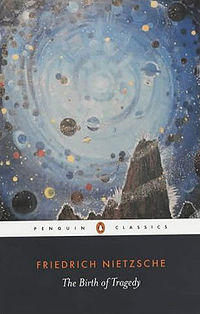
The Birth of Tragedy was the first book written by Friedrich Nietzsche. It was published in 1872 while he was just 28 years old. It did not meet a saluting audience at that time. The Birth of Tragedy was further entitled Hellenism and Pessimism. Nietzsche found in the classic tragedies a meaningful way in human suffering. Download the free PDF e-book here:
 Nietzsche -The Birth of Tragedy
Nietzsche -The Birth of Tragedy
– You can buy the paperback version here: Link
What is The Birth of Tragedy by Friedrich Nietzsche about?
“The Birth of Tragedy,” first published in 1872, is a work of philosophical theory by the German philosopher Friedrich Nietzsche. It marked Nietzsche’s first published book and was a radical reinterpretation of ancient Greek art and culture. However, it also served as a profound insight into modernity and its discontents.
Here are some key themes and ideas from “The Birth of Tragedy”:
- Apollonian and Dionysian Principles: Nietzsche identifies two opposing forces evident in Greek tragedy: the Apollonian and the Dionysian. The Apollonian aspect represents the pursuit of order, beauty, perfection, and individual distinction, with clear boundaries and forms often associated with the dream state. This is named after Apollo, the Greek god of the sun, who stands for light, clarity, and form. On the other side is the Dionysian, which signifies human nature’s chaotic, passionate, irrational, and instinctual aspects, associated with intoxication and loss of self through complete merging with the collective. Dionysus, the god of wine and ecstasy, represents these traits. Greek Tragedy, Nietzsche claims, achieved its peak by harmonising these opposing forces.
- Critique of Rationalism and Enlightenment: Nietzsche saw the Socratic focus on reason and logic—hallmarks of Enlightenment philosophy—as a damaging constraint on the human spirit. He believed that the rational emphasis denied the profound wisdom in human nature’s chaotic, irrational depths, particularly emotions, instincts, and art.
- harmonisingTragedy and Art: In the original Greek tragedies, Nietzsche saw the highest expression of human artistic endeavour because they embraced the full spectrum of human experience. They didn’t shy away from suffering, chaos, or the darker aspects of human nature. Instead, these tragedies presented a holistic view of existence, helping individuals confront the harsh realities of life and find catharsis.
- Decline of Culture: Nietzsche mourns what he sees as the decay of culture under the weight of rationalism, didacticism, and scientific positivism. He posits that society has lost its artistic vibrancy and capacity for creative renewal, which were present in ancient Greek culture through the synthesis of the Apollonian and Diendeavouronysian. He criticizes modernity’s inability to acknowledge and reconcile the inherent suffering and irrationality of human existence.
- Perspectivism and Truth: While not as developed as in his later works, “The Birth of Tragedy” hints at Nietzsche’s idea of truth as perspective-bound rather than absolute. He is critical of the notion of objective truths, suggesting that individuals create truths based on their unique experiences and perspectives, especially evident in art and cultural expressions.
- Music and Metaphysics: Nietzsche holds music in a special category, considering it the fundamental art form and most direct expression of the Dionysian spirit. He believes music taps into the primal, emotional, and existential experiences of life in a way that other art forms cannot, connecting deeply with the innermost aspects of human nature and the universe.
“The Birth of Tragedy” was controversial and largely misunderstood when it was published, and it received considerable criticism, especially from the classical philology community, of which Nietzsche himself was a part. Despite this, the book remains a critical cornerstone in Nietzsche’s body of work and has had a lasting influence on the fields of aesthetics, philosophy of art, and cultural criticism. It provides deep insights into his thoughts and presages the ideas that would shape his later, more mature philosophical works.

Thanks for the books!
You are welcome Lazy Bird!
Thank you very much for this! It is a book worth reading.